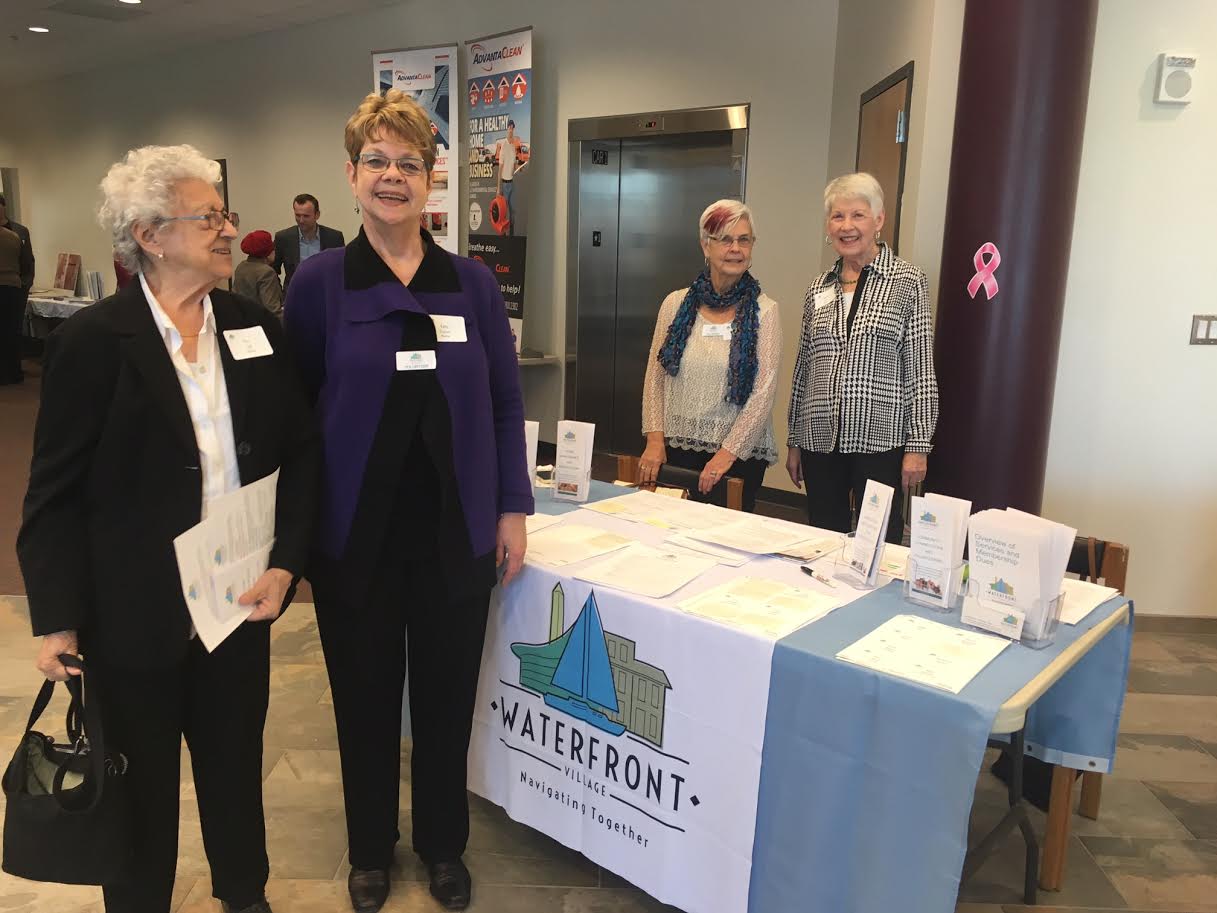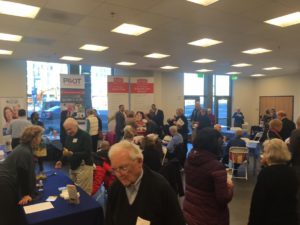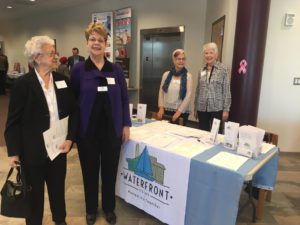


Some 100 Southwest residents turned out at St. Augustine’s Episcopal Church on a cold, windy February night to celebrate the official launch of Waterfront Village—a neighborhood effort to enable southwest residents to “age in place,” i.e., remain in their own homes as they age into their 70s, 80s, and even beyond. Neither a government-sponsored social service nor a corporate enterprise, a village is simply neighbors as they age. That help might mean direct person-to-person assistance, referrals to reliable contractors, or group activities (social activities, informational seminars). It’s up to the individual members.
The celebration/fundraiser began with an “expo” where some 12 local vendors offering home modification and maintenance services, medical and dental services, and more answered attendees’ questions one-on-one. Galley Foods, a local meal delivery service, offered samples of their food.
Inviting attendees to “poke around” the beautiful newly renovated church facilities, Rev. Martha Clark said she looks forward to partnering with the neighborhood to make St. Augustine’s a “well-used living space all week long, not just on Sundays.”
At sunset the friendly crowd moved upstairs to the glass-walled sanctuary for a town hall meeting moderated by Tommy Wells, former Ward 6 councilman who now directs the D.C. Department of Energy and Environment. Wells said he is a big fan of Southwest, calling it a “special neighborhood” with a unique sense of community and civic responsibility.
He introduced a four-member panel: Bob Craycraft, executive director of Waterfront Village; Rita Coll, an 89-year old Waterfront Village member; steering committee member Wilma Goldstein; and Wes Ven Johnson, a steering committee member who was also recently elected to the Village Board.
Craycraft, former ANC member for the area, noted that discussions of a possible senior village for the Waterfront/Navy Yard neighborhood began in May 2013. Around that time he went to visit his father in Ohio who was ill and noticed that their neighbors coalesced around him to help him. This was in sharp contrast to one of Bob’s 6th Place SW neighbors, who was recovering from an attack on Metro and receiving no attention from any of their neighbors. They were “good people,” he says, “but they just didn’t know how to help and there was no mechanism for that.”
Newly retired and looking for a way to give back, he was intrigued by what he was hearing about the senior village concept from Barbara Ehrlich and others, and came on board in Oct. 2015 as executive director and Waterfront Village’s only paid staff. Village membership sales began in Sept. 2016.
Village members can request a variety of services as needed: help with household chores, periodic “friendly visits,” and rides to the grocery store or medical appointments.
New member Rita Coll spoke next, praising those services: “I’ve only been a member since December, but already my life has changed. You give me a lot for my dime. Best of all is that I’ve come into a group of people my age in my neighborhood. I may eventually have to move into a situation with more help, but maybe not as soon as I would have without the Village.”
Speaking next, Wilma Goldstein recalled visiting her parents in an assisted living facility in Michigan and being told by her father that he had been scolded by the staff for going out for a walk in the snow. “No way,” she thought. “I need freedom and control over my own life.” She plans on staying in her home indefinitely, surrounded by the familiar faces of neighbors and going to Jazz Night at Westminster every Friday. She says: “If one Saturday I leave this world after Friday Night Jazz at Westminster, I’ll go out with a smile on my face.”
Wes Ven Johnson, a volunteer since the early days of the Village, explained his take on the village concept. “It’s simple! We love our homes, we love our community, and we want to stay here. Why not match up people with a little extra time and people who need a little help?”
The launch date was chosen to coincide with the 15th anniversary of the opening of the nation’s first senior village, in central Boston’s Beacon Hill neighborhood. The plan was to watch a video live stream from that celebration, featuring Being Mortal author Dr. Atul Gawande, but a blizzard in Boston scrubbed the event.
Beacon Hill Village enrolled its first members in Feb. 2002 and was soon deluged with requests for help from other groups wanting to create their own senior villages. More than 200 villages are now active in 45 states and DC, with more than 150 in development, serving 40,000 members. In 2010 the Village to Village Network was formed, to ensure the success of individual villages and the movement as a whole through expert guidance, resources, and support (www.vtvnetwork.org).
The DC area has by far the most senior villages per capita—Waterfront Village will be the 12th in the District, and the 43rd in the metropolitan area. Those who wish more information about the Village can contact: info@dcwaterfrontvillage.org or call 202-656-1834.
By: Ann Kurzius

